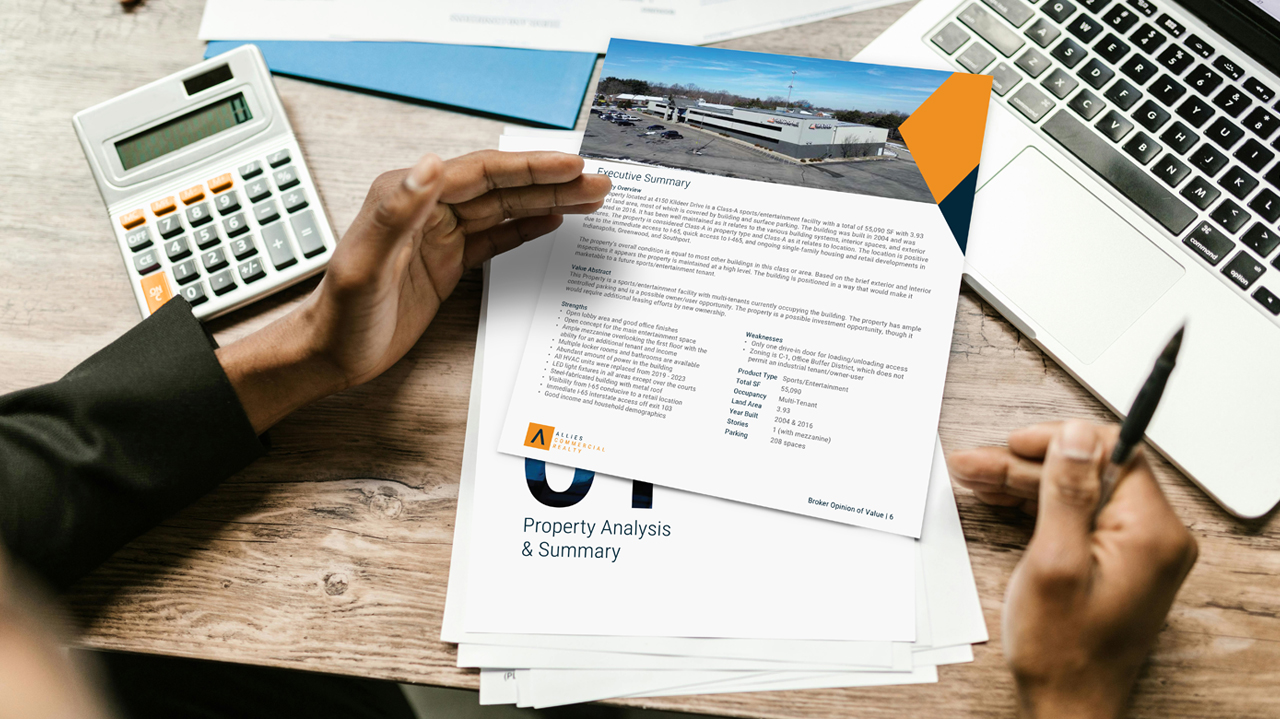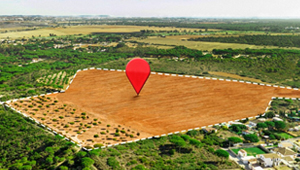How to Use a BOV to Make Smarter Real Estate Decisions

Unlike formal appraisals, which follow regulatory guidelines and can be time-consuming, a BOV offers a quicker and cost-effective alternative based on real-time market conditions and comparable sales. This insight allows property owners, investors, and lenders to set realistic expectations, identify opportunities, and make data-driven choices. Understanding how to obtain and interpret a BOV can give you a strategic advantage, whether you are preparing to sell, evaluating an acquisition, or exploring financing options. In this article, we’ll break down the essential components of a BOV, its benefits, and how to use it effectively in commercial real estate decision-making.
Understanding Broker’s Opinion of Value (BOV)
A Broker’s Opinion of Value (BOV), a broker price opinion (BPO), is a professional assessment of a commercial property’s estimated market value conducted by a licensed broker. The broker analyzes recent comparable sales, rental trends, and overall market conditions to determine the value. The BOV provides a quicker, cost-effective assessment and is a practical alternative to formal appraisals for sales, acquisitions, and financing decisions. Sellers use it to establish competitive asking prices, ensuring their properties are positioned effectively in the market. Investors rely on BOVs to evaluate potential acquisitions and determine whether a property aligns with their financial strategy.
Additionally, lenders may request a BOV to assess a property’s suitability as loan collateral, mainly when a formal appraisal is not immediately necessary. Beyond its role in transactions, a BOV provides valuable insights for long-term strategic planning, helping stakeholders identify emerging market opportunities and make informed investments.
Difference Between BOV and Appraisal
Understanding their unique characteristics is essential before requesting a Broker’s Opinion of Value (BOV) or an appraisal. Each serves a different function, making one more suitable than the other, depending on the situation. Below is a comparative analysis of these two valuation approaches:
- Conducted By: A BOV is prepared by a licensed real estate broker who is an expert in market trends, comparable sales, and local economic factors. In contrast, an appraisal is conducted by a state-certified or licensed appraiser who follows industry regulations and professional standards.
- Purpose: A BOV is commonly used for sales, acquisitions, lease negotiations, and preliminary financing assessments. It provides a practical and efficient way to gauge a property’s market value. On the other hand, an appraisal is required for legal, financial, and regulatory purposes, including mortgage underwriting, tax assessments, and litigation.
- Methodology: A BOV estimates property value using market trends, comparable sales, rental data, and broker insights. Appraisals employ a more structured approach, utilizing formal methodologies such as the Sales Comparison, Income, and Cost Approaches, in compliance with the Uniform Standards of Professional Appraisal Practice (USPAP).
- Legal and Financial Recognition: A BOV is an informal valuation tool used primarily for internal decision-making, such as listing prices, evaluating commercial real estate investment opportunities, and conducting preliminary collateral assessments. In contrast, an appraisal is legally recognized and required for formal financial transactions, including loan approvals, tax evaluations, and court proceedings.
- Cost Considerations: A BOV is a cost-effective valuation tool, making it a preferred option when a quick market assessment is needed. Conversely, an appraisal costs more due to its extensive research, regulatory compliance, and formal reporting requirements.
- Timeframe: A BOV can typically be completed within a few days, offering a rapid valuation option. In contrast, an appraisal is more time-intensive, often taking several weeks due to its detailed analysis and compliance with industry standards.
Steps in Determining a BOV
Determining a BOV involves on-site property evaluations, analyzing property-specific data, and researching comparable sales and rental rates to establish an informed and reliable value. To estimate the fair market value of a property, a commercial real estate brokerage firm follows a systematic process that generally includes the following key steps:
Step 1: Commercial Property Inspection and Physical Assessment
The broker starts by visiting the property to evaluate its condition, layout, unique features, zoning, and legal issues. This includes assessing potential maintenance needs or upgrades that might impact its value.
Step 2: Market Comparison and Historical Sales
Brokers gather market data to establish a competitive price range and analyze recent sales, lease terms, and comparable property conditions. They also review historical sales data, as past sale prices provide insight into the property’s appreciation or depreciation over time.
Step 3: Income Potential Evaluation
Brokers gather data to assess financial metrics such as rental income, occupancy rates, and operating expenses for income-producing properties. Tools like the Capitalization Rate (Cap Rate) and Gross Rent Multiplier (GRM) determine the property’s value based on its income-generating capacity.
Step 4: Market Conditions
The broker considers current market trends, including local demand and economic factors, such as interest rates, to ensure the BOV reflects the prevailing market conditions.
Key Components of a BOV Report
A Broker’s Opinion of Value (BOV) report is a critical resource for buyers, sellers, and investors. It offers insights into market conditions and property specifics. This report is structured around several key components that collectively inform the valuation process. Below, we discuss the key elements of a BOV.
Property Description
Every BOV report provides a comprehensive overview of the property as it sets the foundation for the valuation. This section outlines:
- The property’s address, type, lot size, building size, and layout ensure all fundamental details are documented.
- The property’s zoning information and permitted uses influence investment potential.
- Any notable features, renovations, or property conditions that impact value.
Market and Local Conditions
Market context and local conditions significantly influence a property’s value. Understanding these external factors is critical. This analysis includes:
- Current market trends that may impact the pricing of the property.
- Local real estate market conditions, including supply and demand dynamics.
- Vacancy rates and rental trends may help in assessing income potential.
- Market outlook and potential investment risks
Comparable Sales and Lease Analysis
One of the most essential parts of the BOV report is the comparison of similar properties, known as “comps.” This section may include:
- Recent sale prices of comparable properties help determine the market-driven value of the property.
- Lease rates and occupancy levels of similar properties help gauge potential income performance.
- Adjustments for property differences such as condition, location, and amenities
- Analysis of how these comps impact that specific property’s valuation
Wondering What Your Property is Worth? Reach out to get a professional valuation!
Schedule a Discovery CallVisuals and Supporting Data
A well-structured BOV report includes high-resolution images highlighting the property’s condition, aerial maps, site plans, and layouts for spatial context. Commercial property market data, charts, and comparative tables further illustrate pricing trends and key financial insights. These elements enhance the report’s clarity, credibility, and value, ensuring more informed decision-making.
Valuation Methods in a BOV
Determining a property’s estimated market value requires a structured methodology. Brokers utilize one or more standard valuation approaches depending on the property type, market conditions, and purpose of the valuation to ensure an accurate and market-driven assessment. The key valuation methods include:
- Sales Comparison Approach: This method estimates value by analyzing recent sales of comparable properties and adjusting for differences in size, condition, and location.
- Income Approach: Evaluate the property’s revenue potential by applying a capitalization rate to its net operating income. This approach is primarily used for income-generating properties.
- Cost Approach: This approach estimates the property’s value by calculating the cost to replace or rebuild it, factoring in depreciation and land value.
Estimated Property Value
This section presents a projected valuation range, giving clients a realistic expectation of property worth based on the analysis and valuation approaches.
Broker’s Insights and Recommendations
Based on the BOV findings, this section provides expert guidance to support informed decision-making:
- Suggested Listing Price: A competitive pricing recommendation to attract buyers.
- Investment Strategies: Insights on pricing, marketing, and property enhancements to maximize value.
- Market Positioning: Guidance on effectively positioning the property in a competitive market.
- Risk & Opportunity Analysis: Evaluation of potential risks and commercial property investment opportunities.
These recommendations help stakeholders optimize value and navigate transactions with confidence.
Utilization of BOV
From setting competitive prices and guiding investment decisions to facilitating negotiations and evaluating portfolio performance, BOVs provide stakeholders with valuable insights that inform strategic decision-making. Below, we discuss utilizing a BOV in different real estate contexts.
- Using BOV to Set Realistic Pricing Expectation: A Broker’s Opinion of Value (BOV) primarily determines a suitable property listing price. By delivering a data-driven evaluation of the property’s value, a BOV enables sellers to strategically position their property in the market, enhancing its appeal to potential buyers.
- Utilizing BOV to Guide Investment and Acquisition Decisions: Investors can effectively harness a Broker’s Opinion of Value (BOV) as a strategic tool to make prudent decisions in property acquisitions. A BOV provides a comprehensive and realistic assessment of a property’s current market value, which is crucial for making informed investment choices. By analyzing this data, investors can identify properties that are undervalued or have the potential for significant appreciation. Additionally, a BOV allows investors to pinpoint high-yield investment opportunities that align seamlessly with their financial goals and overall strategic vision.
- BOV as a Negotiation Tool: A Broker’s Opinion of Value (BOV) is an essential negotiation tool for buyers and sellers in commercial real estate transactions. By providing data-driven insights, a BOV supports the justification of pricing positions during sales and lease discussions. It helps mitigate pricing disputes and aligns expectations by presenting objective data, including comparable sales, market trends, and property performance. This transparency streamlines negotiations, maximizing deal value and allowing sellers to secure more favourable offers while enabling buyers to make well-informed purchasing decisions.
- Facilitating Loan and Financing Decisions: A BOV provides lenders with a quick, preliminary property valuation, aiding the loan approval process and reducing lending risks when complete appraisals aren’t required.
- Monitoring Portfolio Performance with Regular BOV Assessments: Periodic BOV assessments provide essential data on asset performance for real estate investors and owners, helping inform strategic adjustments that ensure alignment with market trends and financial objectives.
Limitations of a BOV
Although a BOV is a cost-effective and efficient valuation method, it has certain limitations when used for decision-making.
- Subjectivity of Opinions: The Broker’s Opinion of Value (BOV) is inherently influenced by the broker’s personal opinions, market experience, and interpretation of market conditions. This subjectivity can significantly impact the valuation process, potentially leading to inflated or deflated property values based on the commercial property broker‘s perspective.
- Not Legally Binding: A BOV does not carry legal authority, unlike a formal appraisal. As a result, it is not suitable for situations requiring a legally enforceable valuation. In such cases, a certified appraisal is required.
- Limited Scope: BOV cannot be utilized in all situations. They are typically used for quick assessments or preliminary evaluations rather than comprehensive evaluations. For securing financing, legal disputes, or tax assessments— BOV cannot be utilized as it requires a legally binding valuation.
- Potential Discrepancies in BOV Assessments: A BOV is primarily based on a broker’s judgment, which can result in significant valuation differences if multiple brokers assess the same property independently. The absence of standardized guidelines can further amplify these discrepancies.
Conclusion
Navigating the complexities of commercial real estate requires a clear understanding of property value. Whether buying, selling, or refinancing, an accurate valuation is crucial for sound financial decisions. A Broker’s Opinion of Value (BOV) provides a practical, market-driven estimate that helps stakeholders assess pricing, investment potential, and negotiation strategies. In a dynamic commercial real estate market, staying informed about property values is essential for success. A well-prepared BOV can serve as a strategic guide, helping stakeholders set realistic expectations, negotiate effectively, and identify lucrative opportunities. While not a substitute for an appraisal, it remains a valuable resource for those looking to make data-driven real estate decisions with confidence.
Topic: Broker Price Opinion
Is Your Property Optimized for Maximum Value? Learn how a BOV can help position your asset competitively.
Talk to a Broker
About the Author - Adam Stephenson, CCIM, SIOR
With over a decade of experience in commercial real estate, Adam is a trusted advocate for privately held organizations, specializing in industrial properties across Central Indiana. Adam brings a wealth of expertise in tenant representation, lease negotiations, and strategic asset acquisitions. A graduate of Indiana University – Indianapolis with a degree in Business Management, he further distinguished himself by earning the prestigious CCIM & SIOR designations. His deep industry knowledge, client-focused approach, and commitment to delivering tailored solutions make his insights invaluable.
Download Our Free Resource:
2025 Edition - CRE Forecast:
Trends And Predictions For CRE.

You might also enjoy reading:
Cookies improve your browsing experience, deliver tailored ads or content, and assess our website traffic. If you click 'Accept All’ you are giving your consent for us to utilize cookies. Check our cookies policy here.
Adding {{itemName}} to cart
Added {{itemName}} to cart




















